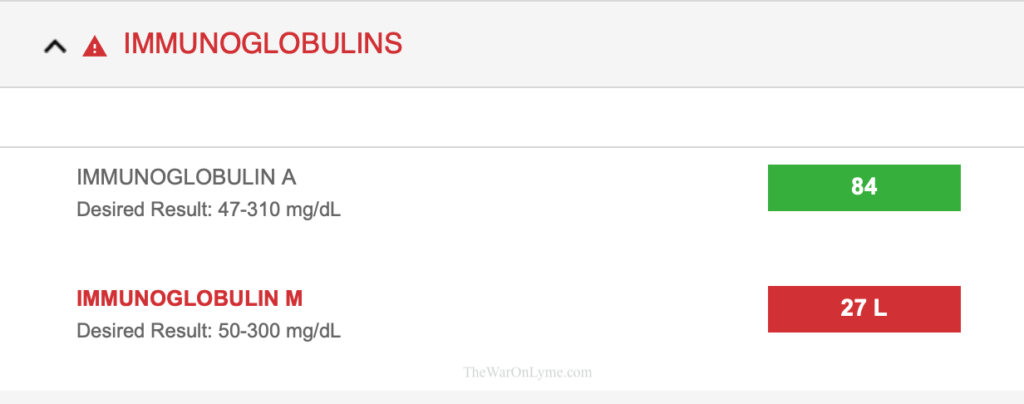Immunoglobulin Levels and Lyme Disease
When my doctor suspected I had Lyme disease, he ordered an immunoglobulin panel as part of a series blood tests. Immunoglobulins are far more complicated than I’m able to understand, but I do know they’re very important for proper immune function. The test took about a week to come back, and when it did, I knew the bright red by IGM was not good.

Some labs may have different range values than others– I’ve found this to be true with various tests, although I’m not sure if it’s true with immunoglobulin tests. The internet gods fail to give me a solid answer from a trustworthy source. My insurance sucks and only pays toward Quest, so that’s the lab where I got my blood drawn. One of the best phlebotomists I’ve ever known works at a specific Quest near my house, and I always make sure to go early in the morning when she’s working. For once, my crappy insurance works in my favor. Anyway, according to their printout, Quest considers 50 to 300mg/dL normal for Immunoglobulin M, or IgM. Mine, highlighted in red on the lab report, showed 27. When I first saw the result, I had no clear idea what it meant other than it probably wasn’t good.
Getting (A Little) Scientific
MedlinePlus, provided by the National Institutes of Health/U.S. National Library of Medicine, explains immunoglobulin tests in a fairly straightforward manner. Here’s a quick excerpt from their article: “This test measures the amount of immunoglobulins, also known as antibodies, in your blood. Antibodies are proteins made by the immune system to fight disease-causing substances, like viruses and bacteria. Your body makes different types of immunoglobulins to fight different types of these substances. An immunoglobulins test usually measures three specific types of immunoglobulins. They are called igG, igM, and IgA. If your levels of igG, igM, or IgA are too low or too high, it may be a sign of a serious health problem.” Read more from MedLinePlus by clicking here.
Lyme disease is a bacterial infection. While that sounds obvious if you’ve known it for a while, I did NOT know it for many years. I first heard about Lyme disease when I visited family in upstate New York as a child. Many years later, definitely well into adulthood, I learned that it’s a bacterial infection. So, if immunoglobulins fight bacteria, then having a low level of them is really bad, especially if you’re dealing with Lyme disease. My doctor told me that one of his main long-term concerns is my IgM level, and now I better understand why.
The million-dollar question, according to my doctor, is, do I have permanently low IgM or is it temporarily low? He wants me to have another immunoglobulin test once my Lyme disease is better under control. The second round of numbers, apparently, is even more important than the first. If my 27 goes up, it’ll be a great sign. If not, he said, I’ll have to worry about various infections for the rest of my life.
